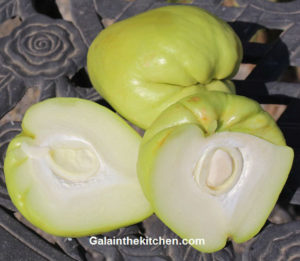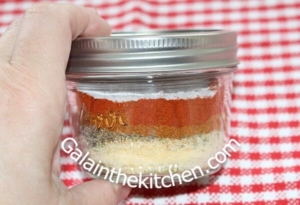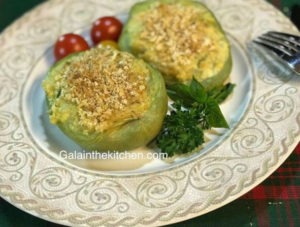How I Prepare Green And Prickly Chayote Squash for Cooking

Green thorn-free and prickly chayote are the same family of fruit (vegetables). However, they have differences in look, taste, and how to prepare these different Chayote squashes for cooking. I cook green Chayote for many years but discover chayote with thorns just recently. I saw Chayote with thorns at our new local Mexican market. The spines of Chayote are very sharp and it is impossible to hold them with a bare hand. In addition, this new to me chayote is more expensive than the green ones without spines. I was very curious to try this new to me chayote squash. It took me some learning, fun cooking, and comparison and I am going to share my favorite technique of how to peel and prepare prickly chayote for cooking and of course how I prepare for cooking green chayote squash.

In the photo above, chayote in our local Mexican market.
*On the market sometimes we can see white-yellow skin chayote squash but I personally didn’t cook it yet and can say anything about it.
On the page:
- Two ways how to protect hands from chayote squash juice (good to know, if you have sensitive skin)
- How to prepare chayote for salad.
- How to prepare green chayote squash fruit for cooking.
- Is chayote seed edible?
- How to prepare prickly chayote squash for cooking (how to peel it).
- Chayote squash botaniccaly is a fruit.
- What we can make with chayote squash?
If you buy chayote with thorns and have it in a bag at the cash register, let the cashier know about it. So, she doesn’t get jabbed by the spines.
1. Two Ways How To Protect Your Hands From Chayote Squash Juice

Louisiana, USA Chayote Squash
I learned the hard way that chayote juice can be very sticky. I was cutting up a few chayote squashes with my bare hands, and after I was done, my fingers were covered in dry, like after glue on my hand’s spots. You can see it in the photo below. My fingers feel so weird for hours. It was a very unpleasant experience! I later learned that chayote juice is not poisonous, but it can irritating to the skin.

On my fingers juice from chayote squash, takes hours to wash out the juice!
Chayote squash juice can irritate the skin, especially, if you have sensitive skin. I suggest always protecting your hands when working with chayote. Here are two methods for protecting your hands from chayote squash juice:
1. Use gloves. This is the most effective way to protect your hands from chayote squash juice.
2. Use vegetable oil. To use vegetable oil, simply coat your hands with a thin layer of oil before starting to work with the chayote. This will create a barrier between the juice and your skin.
*If you do not have gloves or vegetable oil, you can use plastic bags to protect your hands. Not so a convenient solution but it works.
After being done working with squash wash hands with soap.

2. How To Prepare Chayote For Salad?

The preparation of chayote for salad is depended on which chayote we use chayote with thorns and thorn-free chayote. Overgrown thorn-free chayote we need to peel and remove the seed before slicing or julienne for salad. However, if it is not overgrown chayote, I just wash well. Chayote with thorns is different. We need to peel and then remove the seed before slicing for a salad no matter it is overgrown or not overgrown. The technique is how to peel prickly chayote you can see below.
If you are going to cook chayote for the salad, boil, steam, or bake like a potato.
3. How To Prepare Green Chayote Squash Fruit for Cooking

The best part of the preparation of green thorn-free chayote is not much to do, except chop or cut it. Chayote from the local Louisiana market I never peel or remove the seed. I just wash it and cut it as I need for cooking. Everything is soft and edible. However, you might need to peel and remove the seed if your chayote is overgrown. Chayote has its own mild taste close to cucumber or zucchini. Can be eaten raw in salad and cooked. Some people like to use it in a salad like cucumber, I personally don’t like this way. I like marinated chayote in a salad and very much like stuffed chayote with shrimp, you can find the recipe on my website, link below. Cooked chayote (mirliton) holds shape well and does not fall apart as zucchini squash, for example, if we overcook it. At the same time, it is very juicy fruit-vegetable.
4. Is Chayote Seed Is Edible?

Yes, chayote seed is edible and has a pleasant slightly nutty flavor. I personally prefer to eat chayote seeds cooked but they can be eaten raw as well.
5. How To Prepare Prickly Chayote Squash for Cooking

Prickly chayote has better flavor than thorn-free skin chayote, in my opinion, and the people who cook it and I spoke about told me the same. On our market, prickly chayote is also more expensive as well. Another difference I noticed the prickly chayote is less watering after cooking and seeds have more flavor than green chayote seeds. However, prickly chayote needs more time and effort when we prepare it for cooking compared to green chayote. Most important to peel it right, so spines do not get to your food.
How To Peel Prickly Chayote Squash

Prickly chayote has as you can see in the photos very sharp and fine spines and we can’t peel it with bare hands. I tried to peel raw and cooked chayote with spines and the best way to peel it raw. The reason is when we cook chayote with spines, chayote meat is softened and spines can go into the meat easily and stick to fruit when we pick it out of the pot or peel it. Another reason chayote with skin will be cooking longer and in the end, we need to peel it anyway the same way as raw. The skin with spines does not come out itself, we need it to peel with a knife after cooking. I tried both ways and it is not a dilemma for me anymore.
We Need
- Kitchen Towel
- Fillet Knife
- Cutting Board
*The knife I like to use with a narrow blade. The knife call a fillet knife. It gives me more flexibility and much less waste of meat compared to if we use a chef’s knife.
Technique
- Hold chayote with a towel. Cut the bottom of the chayote off. Now chayote can stand on the cutting board.

2. Peel the chayote with a knife by rotating it on the cutting board.

3. Next step after peeling, I cut in half or in quarters chayote. Then cut off cavities on the bottom and the top.

In the photo below, I am peeling boiled chayote with spines. As you can see chayote holds shape very well and spines are still very sharp. I did it to compare for myself and it is not my favorite way to do it, now I know for sure.

6. Chayote Squash is a Fruit

Chayote squash botanically is a fruit according to books I read from my local library but we cook this fruit like a vegetable for savory dishes and we can cook as a pear for desserts. The difference between pear and chayote is not sweet like a pear. It is grown in tropical and subtropical climates in the World, including the South of Russia. Leaves and roots and first-year even tubes of the fruit are edible. This fruit has so many names around the World. Chayote squash, mirliton, vegetable pear, Mexican pear, chook, chocho, choko, Pimpinella, Christophenes, and much more. According to one of the books I read, over 30 names around the world have this fruit vegetable. I am originally from Russia and we grow chayote at gardens in South Russia as well but not grown commercially. It calls chayote or Mexican cucumber in Russia. In the USA, where we live chayote is grown in Hawaii, South of Florida, Louisiana, Mississippi, South of Oklahoma and Southern California. In my photos you see Louisiana chayote, call here mirliton. It has been grown on the Gulf Coast of the USA since at least 1867 according to our local cooking magazine “Rouses Markets”.
7. What Can We Make With Chayote Squash?

So many ways to cook chayote! So many chayote recipes around the World to try! Chayote can be used in sweet and savory dishes. In Louisiana cookbooks, I saw desserts like mirliton (chayote) cake, pie, grace, puddings, tarts, sauces, and fritters. Chayote is well paired with shrimp in cream soups, we can make other soups as well with chayote, we can stuff it, saute it, or fry it. Mirliton is great for canning because holds a very well shape when we cook it. We can pickle it like green beans. So many ways to cook chayote! On my website, you can find a few recipes with chayote. Really good fruit-vegetable to add to our menu!
Chayote Keeps The Shape After Be Cooked Twice
In the photos below, I show how well chayote keeps its shape after cooking and I cooked it twice. I used boiled and already cooked chayote in this simple vegetable side dish. I fried it with other vegetables, so chayote gets the flavor of the bacon and other vegetables. As the result, both chayote still keep the perfect shape. In the photos, the not peeled is a green chayote slice, and the peeled is a prickly chayote slice.



⇓ Check Out My Other Recipes ⇓

 Recommended ⇒ Louisiana Stuffed Chayote Squash Recipe (with photos).
Recommended ⇒ Louisiana Stuffed Chayote Squash Recipe (with photos). Recommended ⇒ My Favorite Cajun Seasoning Mix Recipe
Recommended ⇒ My Favorite Cajun Seasoning Mix Recipe Recommended ⇒ Chayote Squash Salad Recipe.
Recommended ⇒ Chayote Squash Salad Recipe. Recommended ⇒ How to Use Bay Leaves in Cooking
Recommended ⇒ How to Use Bay Leaves in Cooking Recommended ⇒ Ceylon Cinnamon And Cassia Difference In Sticks and Powders
Recommended ⇒ Ceylon Cinnamon And Cassia Difference In Sticks and Powders Recommended ⇒ Russian Squash Spread Recipe – Kabachkovaya Ikra
Recommended ⇒ Russian Squash Spread Recipe – Kabachkovaya Ikra Recommended ⇒ Louisiana Stuffed Chayote Squash Recipe (with photos).
Recommended ⇒ Louisiana Stuffed Chayote Squash Recipe (with photos). Recommended ⇒ How To Roast Beets In Foil In The Oven
Recommended ⇒ How To Roast Beets In Foil In The Oven @Galainthekitchen.com
@Galainthekitchen.com @Galainthekitchen.com
@Galainthekitchen.com


 @Galainthekitchen.com
@Galainthekitchen.com @Galainthekitchen.com
@Galainthekitchen.com
Leave a Reply
Want to join the discussion?Feel free to contribute!